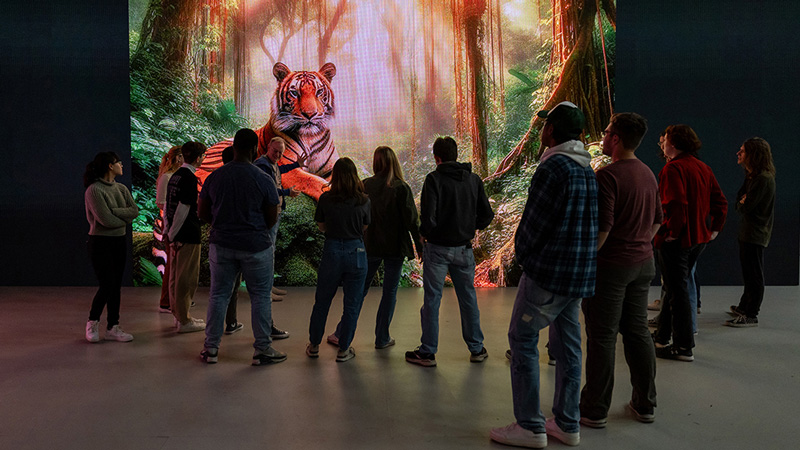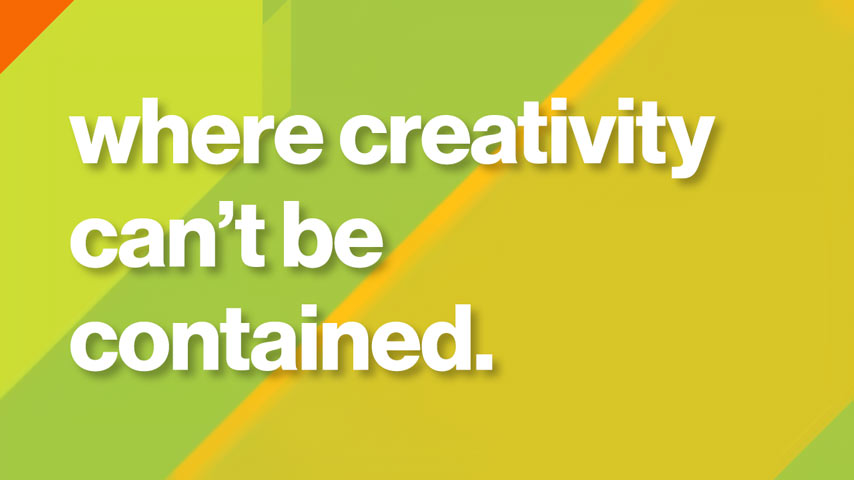Film and Animation Bachelor of Fine Arts Degree

Film and Animation
Bachelor of Fine Arts Degree
- RIT /
- College of Art and Design /
- Academics /
- Film and Animation BFA
A film and animation degree focused on production, screenwriting, 2D animation, 3D animation, and stop motion animation.
$61.5K
Median First-Year Salary of RIT Graduates from this degree
#12
Top 50 Animation Schools and Colleges
Overview for Film and Animation BFA
Why Study Film and Animation at RIT
Focused Degree Options: Choose one of two options: animation or production.
Get Ahead in the Summer: Enjoy the School of Film and Animation’s limited selection of courses during the summer term.
Study in LA: Spend a semester in Los Angeles with RIT in LA, where you can intern at top studios and entertainment companies.
The film and animation degree develops your production skills and promotes film and animation as creative media. Utilizing research, critical thinking, creativity, and a range of problem-solving principles, you will address complex motion imaging workflow issues within the constraints of time, space, budget, and technology.
RIT’s Film and Animation BFA
The film and animation degree prepares you to produce, creatively and practically, your own independent work and/or fulfill professional production responsibilities in any medium suitable to your interests and abilities.
Through lectures and laboratories, you will develop individual skills in moving-image communications and learn the aesthetic principles governing art. Technology and technique are taught as a means to achieve a creative goal.
Film and Animation BFA Options:
As a film major, you have two options to choose from to pursue your craft:
- Animation option – This animation BFA on 2D, 3D, and stop motion animation spanning from conception to application to final production of short films.
- Production option – This focuses on production through visual and sound artistry utilizing hands-on experience with camera, editing, and sound equipment.
Production work occurs throughout every semester, with students producing several short films in either live-action or animation by working through all phases of production, from scripting, production planning, and budgeting to shooting, designing, animating, editing, and sound design. Students further their learning of visual and sound artistry through hands-on experience with camera and sound equipment. Film, video, and animation projects are designed by individual students. A wide variety of styles and intentions is expressed in the department’s work.
The School of Film and Animation also offers a limited selection of courses ranging from beginning courses to those requiring a substantial background during the summer term.
Network and build lasting connections with several professional organizations, including:
- Animation World Network
- College Art Association
- Rochester Audio Visual Association
- Society of Motion Picture and Television Engineers
- University Film and Video Association
- Siggraph
- BEA
Hands-On Experience to Gain Real World Skills
RIT in LA gives film bachelor’s degree students the opportunity to spend a semester in Los Angeles learning from industry professionals. The bulk of your time will be spent doing internships, but you'll also complete two courses that will complement your study-away experience.
Interested in a Career in Game Arts?
We’ve got you covered. The film and animation major allows you to explore your creative interests related to video games. You'll have endless opportunities to collaborate with developers and fellow artists on game and digital media projects. Film and animation alumni have gone on to establish successful careers as game artists. Learn how you can use the film and animation major to launch a career in game arts.
Furthering Your Education in Film and Animation
Combined Accelerated Bachelor's/Master's Degree
Today’s careers require advanced degrees grounded in real-world experience. RIT’s Combined Accelerated Bachelor’s/Master’s Degrees enable you to earn both a bachelor’s and a master’s degree in as little as five years of study, all while gaining the valuable hands-on experience that comes from co-ops, internships, research, study abroad, and more.
+1 MBA: Students who enroll in a qualifying undergraduate degree have the opportunity to add an MBA to their bachelor’s degree after their first year of study, depending on their program. Learn how the +1 MBA can accelerate your learning and position you for success.
-
First-Year Applications Due Soon
Apply by Jan. 1 for Early Decision II and by Jan. 15 for Regular Decision.
-
Join Us for Accepted Student Open House
Visit campus on March 28 or April 11 to meet faculty, tour campus, and ask your questions.
Careers and Experiential Learning
Typical Job Titles
| 3D Modeling and Character Designer | Art Director | Camera Operator |
| CG Painter | CG Lighting PD/TD | Character Animator |
| Digital Paint Artist | Director | Editor |
| Effects Animator | Layout Artist | Key Grip |
| Post-production | Producer | Production Manager |
| Production Sound Mixer | Screenwriter | Supervising Sound Editor |
| Visual Effects Supervisor | Writer | Animator |
| Broadcast Technician | Gaffer | Production Runner |
| Visual Designer |
Industries
-
Movies, TV, and Music
-
Tourism
-
Health Care
Cooperative Education and Internships
What’s different about an RIT education? It’s the career experience you gain by completing cooperative education and internships with top companies in every single industry. You’ll earn more than a degree. You’ll gain real-world career experience that sets you apart. It’s exposure–early and often–to a variety of professional work environments, career paths, and industries.
Co-ops and internships take your knowledge and turn it into know-how. Co-op in the College of Art and Design provides hands-on experience that enables you to apply your artistic capabilities in dynamic professional settings while you make valuable connections between classwork and real-world applications.
Cooperative education, internships, and other experiential learning opportunities are strongly encouraged for students in the BFA in film and animation.
Creative Industry Days
Connect with Design Industry Leaders
RIT’s Office of Career Services and Cooperative Education hosts Creative Industry Days, which connects students majoring in art, design, film and animation, photography, and select computing majors with companies, organizations, creative agencies, design firms, and more. Creative Industry Days are a series of events that allow you to network with company representatives and interview directly for open co-op and full-time employment positions.
Featured Work and Profiles
-
RIT project increases representation in animated films
The Character Mosaic Project, led by School of Film and Animation faculty and students, is providing animators more pathways for creative storytelling by developing a library of free characters rigs....
Read More about RIT project increases representation in animated films -
Experience Film and Animation in Los Angeles
For students interested in a career in the entertainment industry, Los Angeles is the best place to learn. RIT in LA is a semester-long study away program that gives School of Film and Animation...
Read More about Experience Film and Animation in Los Angeles -
RIT, NTID team up to create pioneering film
Students Anna McClanahan (BFA) and Gabriel Ponte-Fleary (MFA) brought together the deaf/hard-of-hearing and hearing communities in creating their finalist film for a Coca-Cola-sponsored program.
Read More about RIT, NTID team up to create pioneering film -
Video Game Development
“That Damn Goat!” is a party game where chaos reigns, frustrations mount and everything you think you know about your situation is instantly thrown out of whack by a head-butting goat with magical...
Read More about Video Game Development -
Sizzle Reel
A collection of student work from Rochester Institute of Technology's School of Film and Animation, which offers a BFA and MFA in Film and Animation and a BS in Motion Picture Science.
Read More about Sizzle Reel -
Stop Motion Animation That Packs a Visual Punch
Friendships formed at RIT helped lay the foundation for Apartment D, an alumni-owned indie stop-motion animation studio. By leaning into their authentic approach to the craft, film and animation...
Read More about Stop Motion Animation That Packs a Visual Punch
Curriculum for 2025-2026 for Film and Animation BFA
Current Students: See Curriculum Requirements
Admissions and Financial Aid
First-Year Admission
First-year applicants are expected to demonstrate a strong academic background that includes:
- 4 years of English
- 3 years of social studies and/or history
- 3-4 years of mathematics
- 2-3 years of science
- A portfolio of expressive, original work must be submitted. View Portfolio Requirements for more information.
Transfer Admission
Transfer applicants should meet these minimum degree-specific requirements:
- A portfolio of expressive, original work must be submitted. View Portfolio Requirements for more information.
Portfolio Guidelines
Specific instructions on portfolio submission for applicants to the film and animation major are available on the college website. The review committee is looking for work that is original in concept and content. It does not necessarily need to be motion media, but should be visual or aural. Examples include films/videos, photos, drawings, paintings, sculpture, stop-motion puppets, scripts, creative writing, storyboards, and original music.
Financial Aid and Scholarships
100% of all incoming first-year and transfer students receive aid.
RIT’s personalized and comprehensive financial aid program includes scholarships, grants, loans, and campus employment programs. When all these are put to work, your actual cost may be much lower than the published estimated cost of attendance.
Learn more about financial aid and scholarships
Accreditation
Related News
-
October 30, 2025

‘TheWrap’ recognizes RIT as one of the nation’s top film schools
Forward-thinking faculty; curriculum that fuses technology, the arts, and design; and a legacy of priming students with a maker mentality helped RIT’s School of Film and Animation maintain its place on TheWrap’s list of Top 50 Film Schools of 2025.
-
September 24, 2025

New School of Film and Animation director, faculty roles for 2025-26
Ricky Figueora taking over as the new director of RIT's School of Film and Animation headlines exciting promotions and additions to the College of Art and Design faculty.
-
September 12, 2025

Digital media projects take shape with help from MAGIC Spell grants
The new MAGIC Spell grants, earmarked for digital media projects in art, games, interactivity, and creativity, provide RIT researchers in any college with funding up to $5,000 to help in their pursuits to secure additional external grants in their fields.
Contact
Brian Larson, Animation Director
Jack Beck, Production Director
School of Film and Animation


















